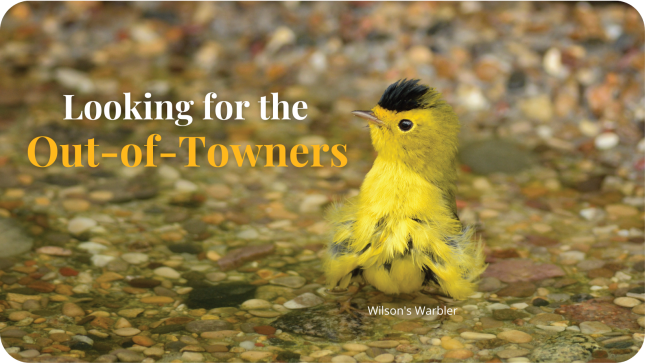
Keep An Eye Out for New Visitors & Old Friends Departing During Fall Migration in New Mexico
Fall is moving in, but that isn’t the only thing new around here. You may have spotted a few feathered out-of-towners that may be sticking around for fall and winter, or just passing through town before moving further south. Others have been with us all summer and will be headed on long-distance migration to Central and South America.
When fall arrives, a bird's life transitions. Summer was nesting time, during which birds set up territories and raise babies. In fall, they are no longer raising families and most of these territories break down. Some birds flock up with their own kind and use the flock as a winter survival tactic, taking advantage of more eyes to search for food and watch for predators.
Some birds mix together with other bird species in a winter foraging flock. This loose foraging guild travels around, learning each other’s alarm calls to protect from danger. They also learn food foraging techniques from each other, such as searching up or down trees.
Fall and winter are great times to look for uncommon bird species. Juncos and other sparrows and finches may be making a repeat appearance in your yard this winter as many of them come back to the same exact location each year.
Keep your feeders full and look for birds associated with “irruptions.” When natural winter food supplies are scarce in northern Canada, numerous bird species “irrupt,” migrating south in search of food. The most common irruptive birds are Pine Siskins, Purple Finches, Common Redpolls and Evening and Pine Grosbeaks.
Be a seasonally savvy bird feeder by offering the right food (in the right place), to better your chances of attracting some of these birds and helping them along their way.
Hummingbirds, Western Tanagers, Bullock’s & Scott’s Orioles
These long-distance migrators will be leaving and heading to Central or South America for the winter. Keep the nectar fresh and available for these birds. Orioles also love grape jelly and oranges. Tanagers are attracted to freshly cut oranges as well.
Warblers - MacGillivray’s Warblers, Yellow-rumped Warblers, Orange-crowned Warblers, Wilson’s Warblers
Add a suet feeder or Bark Butter to appeal to these insect eaters.
Juncos
Lovers of millet, you can attract Juncos to your yard by offering WBU Deluxe Blend in a ground feeder or hopper feeder. They’re persistent foragers and have been known to burrow through snow in search of seeds.
Pine Siskins, Purple Finches & Common Redpolls
These “winter finches” are attracted to WBU Finch Feeders filled with Nyjer® or WBU Finch Blend. You can also attract them to your Seed Tube Feeders by offering blends with sunflower chips like our WBU No-Mess Blend.
Grosbeaks
If they’re visiting your yard, be ready - they are hungry birds. For best results, offer Supreme Blend in a Hopper Feeder. Before the 1850s, Evening Grosbeaks were not commonly found east of the Rocky Mountains. Now, winter irruptions can occur across the country.
As you can see, our feathered guests’ tastes and preferences vary, so it’s important to be prepared. Because, before you know it, these out-of-towners will be just that - headed out of town.
How to Attract & Help Birds During Fall Migration
Attract birds with low-lying landscapes.
Overall, a varied, dynamic landscape that is not completely manicured will help attract birds during the fall. Take a look at your landscape, try to leave some natural roughage. If possible, leave weed-seed plants. Many birds, like finches, sparrows and juncos, love to work on them.
Put out a few brush piles. It gives birds a place to hide from weather and predators. It also gives them a place to loaf and socialize before and after eating at your feeders. Ground-feeding environments attract birds that avoid elevated food sources. Song sparrows like to feed this way and are just about everywhere in North America.
Attend to bird feeding stations.
Fall is the perfect time to attend to your bird feeding stations. Take the opportunity to clean and repair your feeders now, because who really wants to care for feeders during winter weather?
Fall is also a great time to move bird feeding stations closer to the house. It will be easier to keep them full during winter’s cold. Plus, regularly moving feeding stations prevents buildup of debris under the feeder, making it healthier for ground-feeding birds.
Fresh food now to attract birds later.
As birds come through and decide where to stay, they are more likely to stay if they note a regularly available food source. Even if they are not hitting the food source on a consistent basis in the fall, once the weather turns cooler, they’ll remember where that reliable source is. By keeping food fresh now, even if it’s a small amount, the birds will reward you once the weather turns.
Provide a moving water source.
A moving water source is a magnet for birds. If a bird is passing through and they see or hear moving water, they will almost always check it out. They need open water sources for drinking and keeping their feathers maintained for flight and proper insulation as the nights get colder.
Stop by the store and we’ll show you the foods, feeders and other products to help attract migrating birds.

